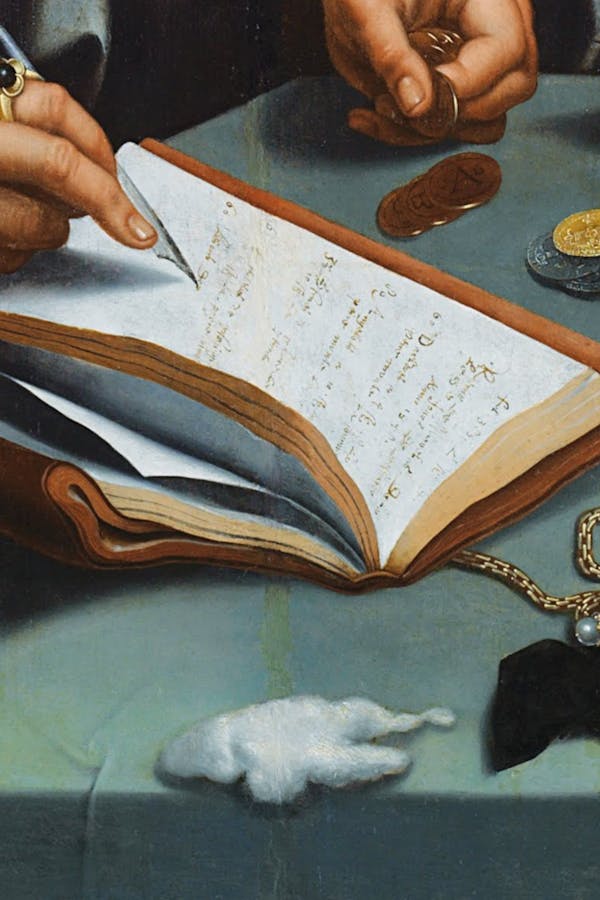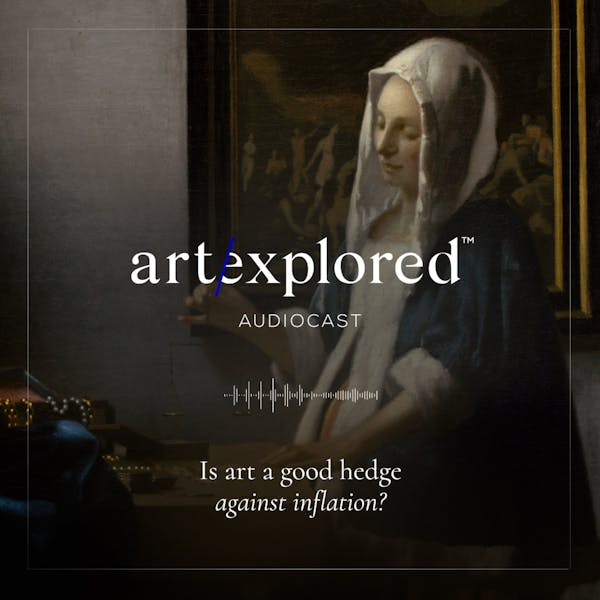Amedeo Modigliani through the microscope
Delve into the artist’s enduring appeal and his use of materials
By William Corwin
What is it about the eyes in Amedeo Modigliani’s painting? The majority of sitters in his paintings in Philadelphia’s Barnes Foundation exhibition Modigliani Up Close simply have grey blank spaces instead of eyeballs, rendering their faces more like masks. In Self-Portrait (1919), the very first canvas one encounters in the exhibition, the artist’s body lilts gently to the right and directs its empty pupil-less gaze slightly over our shoulder. Oddly, this missing ingredient doesn’t detract from the sense of personality we get from the bemused rakish Italian-Jewish artist clutching his palette to his chest. He would die a year later, and his eight-month-pregnant wife and muse, Jeanne Hébuterne would commit suicide the day after by jumping out of a window. She inhabits seven of the paintings in Modigliani Up Close.
Legends and questionable anecdotes immediately began to swirl about the artist following his untimely death, and his radical, oft-ridiculed painting style, enigmatic eyeless faces, and penchant for painting lovers only fueled mounting interest in his work. His paintings have continued to grow in value, and he has simultaneously become a darling of forgers.

Modigliani Up Close brilliantly uses the science of painting conservation and such initially daunting technologies and methodologies as X-ray fluorescence mercury mapping and the Thread Count Automation Project to sift through the forgeries and myths about the fabled artist and begin to paint a portrait of the man who captured others so profoundly.
Like a meticulous prosecutorial team building a sturdy case, the curators of the exhibition, a combination of academics and conservators – Barbara Buckley, Simonetta Fraquelli, Nancy Ireson, and Annette King – construct a narrative based on data gleaned from samples and scans. We watch the 22-year-old Italian artist, new to the burgeoning Parisian art scene in 1906, begin by slumming it – buying old canvases and painting his own images over them, as in The Pretty Housewife (1915). Or Modigliani simply recycled a canvas – more than a few times – such as the palimpsest-like double-sided painting Nude with a Hat (recto), Maud Abrantès (verso) (1908); X-radiography has revealed an additional pair of portraits lying below the final paintings. The curators are quick to affirm that this was common practice among bohemians at the time (and before and since). But other details, such as Modigliani’s use of a previous artist’s colours in the basket in the hand of The Pretty Housewife, and his penchant for reusing canvases even when he had adequate funds to purchase fresh canvas and stretchers, seem to indicate individual aesthetic choices such as pulling inspiration from an already existing painting and adding an unexpected depth to his own, or a fascination with the unexpected textures of recycled paintings, respectively.


The Thread Count Automation Project has been able to identify the signature pattern of threads in a roll of canvas and can place various paintings on the same roll. As Modigliani and his art dealer were purchasing premade canvases from manufacturers in Paris and the south of France, this path of research can authenticate a Modigliani painting beyond reasonable doubt. Modigliani’s Le Nu Couché (sur la côté gauche) (1917) sold in 2018 for $157.2 million, and considering that 20 out of 21 paintings were declared forgeries at a 2017 exhibition at the Palazzo Ducale in Genoa titled Modigliani, the need to prove that the works were actually created by the artist himself has become a significant concern.
Like a druid’s mystical circle of stones, eight of Modigliani’s delicate and slender female heads form a klatch at the centre of the first gallery in Modigliani Up Close. This in part mimics the arrangement of the artist’s sculptural practice in the Cubist room of the Salon d’Automne in 1912, preserved in photographs. The sacred geometry of the presentation also pulls from accounts from the artist’s contemporaries of his inclination to create a temple-like atmosphere in his studio, with candles nestled on the crowns of his heads casting flickering shadows across the sinuous features. Conservators discovered wax traces on the sculptures, confirming this enlightening anecdote. Analysis of the limestone, and the block’s original shape before the carving began, offers another fascinating detail: that Modigliani purchased (or stole) pieces of stone destined for door jambs and lintels in buildings in Paris. Did these long narrow architectural elements inspire the artist to make elongated sculptural forms, or was he searching out blocks of this shape?
The first gallery flows into a room of elongated languorous gently writhing nudes: Nude with Coral Necklace (1917), Nude (1917), Seated Nude with a Skirt (1917), Reclining Nude (1917), and Reclining Nude (1919). Encompassed by a sea of pinks, much like being encircled by the ring of beige oolitic limestone in the first gallery, the viewer can watch Modigliani tweaking and refining his vision, he tilts his model’s hips forward and back, plays with line versus alternating shades of colour, and tries different props in order to heighten the sense of erotic connection between the sitter and the artist/viewer. Each of the galleries allows the viewer to explore the artist’s investigations based on type: light-filled portraits of bored pink-cheeked boys roped into modelling during his convalescence in 1918-19 in the south of France and in the final room a magnificent trio of large format paintings of the ill-fated lover Jeanne Hébuterne: Jeanne Hébuterne in a Yellow Sweater (1918-1919), Portrait of Jeanne Hébuterne (1918), and Jeanne Hébuterne (1919). Modigliani Up Close does not end in the allotted gallery space: because of the esoteric requirements of Albert Barnes himself – the paintings in the permanent galleries cannot be moved from their existing arrangement on the walls, so the visitor has to visit the foundation’s collection in order to see several of Modigliani’s greatest masterpieces, such as the aforementioned The Pretty Housewife, as well as the roguish portrait of the artist’s dealer Leopold Zborowski (1919), and Boy in a Sailor Suit (1917). Modigliani and his friend Soutine were some of the earliest artists to enter Barnes’ collection, and by seeing the paintings amongst Renoirs, Picassos, and Matisses, we begin to understand the mysterious Modigliani, who died so young, in the art ecosystem in which he was a vital part.
Modigliani Up Close
16 October 2022 - 29 January 2023. The Barnes Foundation, Philadelphia.

Read more
Listen to audiocasts
Discover more artists











